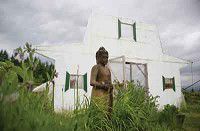Center yourself
Published 7:37 am Thursday, June 24, 2010

- Statues can be found throughout the grounds of the Great Vow Zen Monastery. A wooden facade decorates the entrance to one of two greenhouses used by the monastery to grow vegetables and flowers.
Who knew that Sunday, May 9, Mother’s Day, was also the Buddha’s birthday? Everyone at Great Vow Zen Monastery. These joy-filled people celebrate life every day, but on this day there was actually a birthday cake that said, “Happy Birthday Buddha.”
A few words about the Zen practice at this monastery are in order here, before we go to the birthday party. Take off your shoes and socks, please; it is a sign of respect.
Great Vow is a residential Zen Buddhist training monastery inspired and guided by Jizo Bodhisattva’s vow to help all beings who suffer, no matter where they are found. The monastery aspires to maintain authentic, whole-hearted practice while keeping the teachings open and accessible to anyone with a sincere desire to practice the Buddha-way.
The particular practice at Great Vow is a synthesis of Soto and Rinzai Zen traditions informed by the practice and study of Chozen and Hogen Bays, teachers at the monastery. At the heart of the training are monthly silent meditation retreats, called sesshin, ranging from six to 10 days. They also offer a variety of workshops and classes ranging from contemplative arts to compassionate communication with the intention of broadening expressions of wisdom in everyday life.
A wooden fence divides the Jizo Garden from the grounds of the Great Vow Zen Monastery outside of Clatskanie. The residential Zen Buddhist training monastery is housed inside the old Quincy-Mayger Elementary School on 20 acres containing open meadows, woods and a small stream.Great Vow is a spiritual refuge and a way to carry the life of the dharma forward. Dharma defies translation into English but is variously defined as religion, law, teaching, one’s righteous duty or that which upholds and supports.
At Great Vow, they practice with Jizo Bodhisattva to help awaken the jizo’s qualities in themselves. A bodhisattva is one who devotes his or her life to freeing others from suffering, perhaps comparable to a saint. Bodhisattvas are not worshipped, but are an inspiration to awaken the qualities of an enlightened being that are inherent in everyone.
Erin Needham, the registrar at the Great Vow Zen Monastery, summons residents to the zendo for meditation by ringing the densho bell.Jizo Bodhisattva is a much beloved figure in Japan, Korea and China, and is becoming increasingly well-known here. Jizo is a special protector of children, travelers and women, and is also known to help those who are working with a life problem or physical affliction. Jizo Bodhisattva is usually portrayed as a child-monk, often carrying a pilgrim’s staff with six rings that jingle to warn animals of his approach and prevent mutual harm.
The monastery has a beautiful Jizo garden filled with lush plants, pathways and several small statues. It is a memorial garden, a place of solace and comfort for anyone who has lost a loved one, especially a child. Close by the Jizo garden is a Japanese rock garden, just now being finished. There is a beautiful stand of bamboo, paths and vistas looking toward mountains and valleys. Every part of the monastery reflects the work that is done every day to maintain the grounds and buildings for the residents and their visitors.
From left, Ryushin Creedon, the head gardener at Great Vow Zen Monastery outside of Clatskanie, is joined by Jogen Salzberg and Sam McCree for chanting in the monastery’s zendo, or meditation hall. The 16 current residents at the monastery spend three to four hours in the zendo for meditation each day.What does a day at the monastery look like? Residents rise at 3:50 a.m. on most days, spend three to four hours of zazen (seated meditation) each day and five to six hours of work and service. Meals, a brief rest period, housekeeping, a closing chant and lights are out at 10 p.m. But, on this celebration day, they slept in – probably until about 5 a.m. – and were smiling as they greeted Sunday visitors.
The first word you hear is “welcome” as you enter this world of simplicity, silence and wholehearted effort. The 10 a.m. service takes place in the zendo, the hall where zazen is held. It is a beautiful, serene room with hardwood floors, rice paper light fixtures and a large Buddha altar. Because it is Buddha’s birthday, in addition to the large altar, there is a bower in the center of the room with flowers and a small Buddha in it. All participants are invited to bathe the baby Buddha by ladling sweet tea on the statue while chanting. The chanting, done then and again at lunch, is haunting and hypnotic rather than melodic. Throughout the service, there are occasional gongs and bells which move us from one part of the ceremony to another.
Residents of the Great Vow Zen Monastery gather in the cafeteria for a meditative dinner called oryoki. The silent meal requires that practitioners pay great attention to detail as each step of the dinner, from serving to eating to the cleaning of the bowls, circles around the table from person to person.After the service, the children go to dharma school and the adults go to beginners’ meditation or remain in the zendo. Beginner’s meditation is led by Daitetsu, a 6’10” monk with a great sense of humor and a way of teaching that makes you believe you can learn to meditate.
DT, as he is called, takes the opportunity of talking to us newcomers about the purpose of meditation. “It helps us to be present to our lives for every moment, to appreciate more of life because we are paying attention, not worrying about the past or what’s next.” He says, “Learn to sit still and accept everything, follow your breath or sounds and let everything else go. Hold yourself lightly, step back from everything else but what you are doing now.” He asks us to sit still and concentrate on our breathing for four minutes. “Don’t move; if you have an itch, don’t scratch; just be still.” It’s possible, but easier said than done. Why sit still? DT tells us that “sitting still cultivates mental discipline, making us better able to go forth in the world.”
Worn Jizo Bodhisattva statues from Japan decorate the memorial Jizo Garden at Great Vow Zen Monastery. Jizo Bodhisattva is a beloved, saint-like figure who is a caretaker of women, children, travelers and those who have died. Some statues are dressed up by a grieving parent in hopes that Jizo will protect them.When our meditation ends, we go to the cafeteria, where there is a puppet show in progress. It’s the story of the birth of Buddha and is touching and funny and very sweet. It combines Chinese, Japanese and Indian practice with such familiars as “She’ll be Comin’ ‘Round the Mountain,” “One Fine Day” and “Blowin’ in the Wind,” with certain liberties taken with the lyrics.
When the show is over, newcomers are invited to tour the grounds while tables and chairs are moved around in preparation for lunch. It is a sunny, beautiful day, no doubt blessed by Buddha, so the walk around the area is very pleasant, accompanied by birdsong and bee-buzz, the sounds that DT recommended as alternatives to listening to our own breath. We reconvene for lunch and, after a brief chant, tuck into a delicious vegetarian buffet topped off with that aforementioned birthday cake.
Everyone at Great Vow Zen Monastery, resident and visitor alike, was friendly, pleasant, welcoming and joyful. The rituals were meaningful and comforting. When it was time to don shoes and socks and go back out into the world, it was hard to say goodbye.









